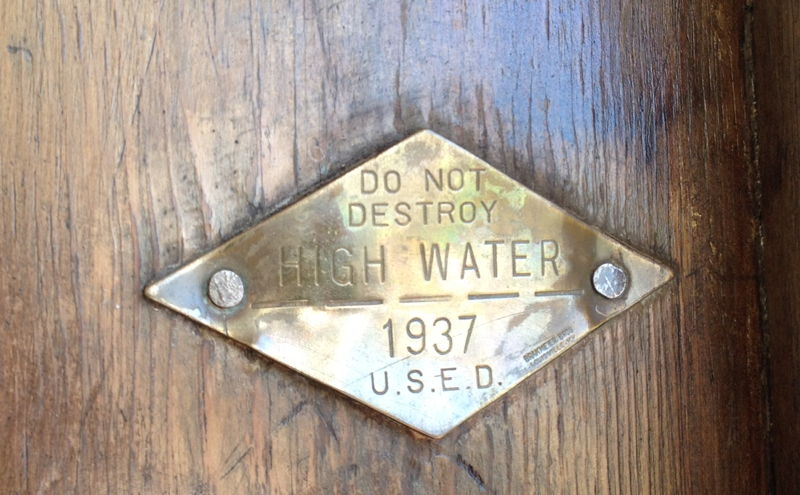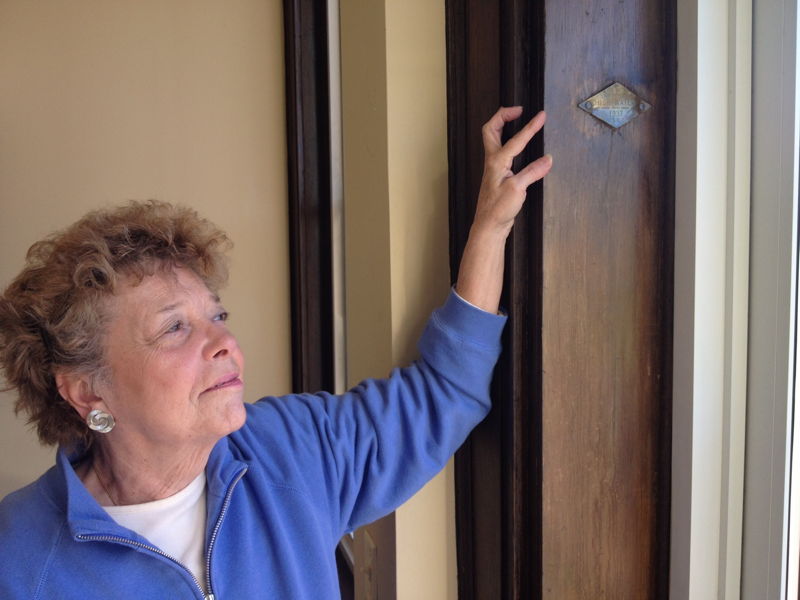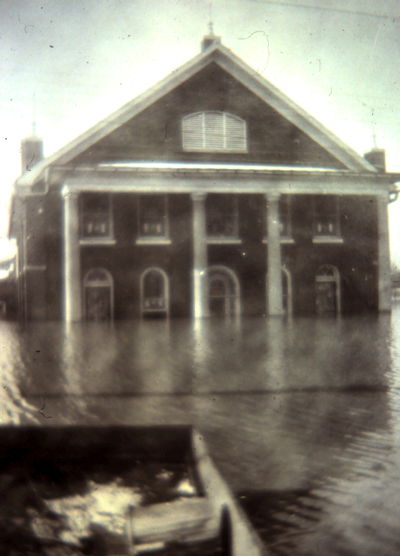
The following article by David Strange originally appeared in The Courier-Journal on 18 Jan 2012. It is archived here with additional information for your reading enjoyment.
Most people never notice it when they walk through the main entrance doors of the Bullitt County Courthouse.
A tiny brass marker on the inside door-frame, about six feet up.

That little brass marker is set at the high water mark of the 1937 flood; by far the worst known flood ever to inundate the multistate Ohio Valley region.
Today, January 18, 2012, is the 75th anniversary of that terrible time in our local history. On that cold January day, the Ohio River passed over its 28 foot flood stage and kept going.

In Bullitt County, as in many areas, the result was devastating. According to the state Health Department report at the time, in Bullitt County alone several thousand dairy cattle and sheep drowned. Financial loss, even in such a rural county, amounted to millions of dollars in today's money. Flooding in Shepherdsville reached fifteen feet. Two fifths of Lebanon Junction was under water. In Bardstown Junction the water was twelve feet deep. Flood waters swept furiously across the road south of Mt. Washington at Smithville.
Entire houses were washed downstream, crashing into bridges along the way.
Even in western Bullitt County, I am told the old Nichols School house was flooded half way up the windows.
Set your sight on that little brass marker in the county courthouse, look out past the door, and imagine a level mark across the town at that height, and you can begin to get an idea of the shock of that flood.
Yet, just the summer before, in 1936, was one of the hottest and most drought-plagued in North American history. In one bit of dark-humor, it has been said that perhaps the flood of '37 was caused by too-earnest prayers to end the drought of '36.
And end it did. The rain started on January 9 and kept coming harder and harder. By the end of January, the Ohio River was overflowing fast and backing up the Salt River and Rolling Fork River. People kept expecting it to stop but it kept coming, faster and faster.
Suddenly farmers couldn't get livestock to high ground in time. In fact, many people barely made it to safety themselves. Some twenty-five percent of Bullitt Countians were directly affected by the flood; many moving in with friends and family and with good-Samaritan strangers.
On January 21, in one story told by Minnie Maraman, she tells of going out to milk cows for what turned out to be the last time. Over the night, flood waters rose and her cows, horse, and a hog all drowned in the barn.
Many people were caught in their homes, surrounded by the rising waters. Bob Moser tells of his father going over to their barn, stripping off some of the boards, and constructing a rough boat. After letting the new boat soak in the water overnight so the wood would swell and seal any leaks, the little boat worked pretty good and the family soon set to work going house to house rescuing neighbors. The long hours were hard work and the cold, rainy weather was miserable. People could get a little testy, but in hindsight some humorous memories were created.
On one rescue trip with the little boat, Bill Moser, the boatman (Bob's brother), rescued two rather large young ladies. After they entered the boat, they would not sit still. Every time they moved, the boat took on water and Bill had to stop and bail. After the third time, Bill took one of the oars, turned around, and said, "The next time one of you moves and makes the boat dip water, I will take this oar and knock you out of my boat! Do you understand me?!" Bill said later that he didn't think the girls breathed after that.
Sadly, Bill would die, along with many others, just a few years later in World War II.
Hundreds of people took refuge from the flood waters wherever they could. The two-story Masonic Hall, then located on the southeast corner of Buckman Street and Highway 44 in Shepherdsville, was itself surrounded by water. Yet one writer from the time said that some two hundred people stayed there. Homes that were on higher ground, sometimes isolated themselves, often housed twenty and thirty people.
This created a food problem and people foraged wherever they could to survive.
Bob Moser tells about when the people at the Cruise family home on Chapeze Lane had used up all the food stored at the house, some of the men went down to a local distillery and got the corn meal mash that was there, using it to make "fried mush for lunch and boiled mush for dinner." One day, unnoticed by anyone, the family geese ate some of the slop that was left over from the whiskey-making process. Eventually, someone looked out and saw the geese, all dead, lying around the yard. Probably thinking it was some malady from the flood, the family put the geese in a pile until the men could return. But sometime later in the day, they heard the geese honking and saw them wobbling around the yard. The geese had just passed out from all the liquor in the slop!
And so, there was humor to be had, even in the darkest of times.
By the first Saturday in February 1937, the waters were beginning to recede much as in the days of Noah, and families made their way back to what was left of their homes and farms, and began the long recovery in a world still reeling from the Great Depression.
Oh what a terrible time, yet what a time to remember.

To only slightly change a phrase from the Charles Dickens book A Tale of Two Cities, "It was the worst of times. It was the best of times."
Many stories and information about the Great Flood of 1937 can be found here.
Copyright 2012 by David Strange, Shepherdsville KY. All rights are reserved. No part of the content of this page may be included in any format in any place without the written permission of the copyright holder.
The Bullitt County History Museum, a service of the Bullitt County Genealogical Society, is located in the county courthouse at 300 South Buckman Street (Highway 61) in Shepherdsville, Kentucky. The museum, along with its research room, is open 10 a.m. to 4 p.m. Monday through Friday. Saturday appointments are available by calling 502-921-0161 during our regular weekday hours. Admission is free. The museum, as part of the Bullitt County Genealogical Society, is a 501(c)3 tax exempt organization and is classified as a 509(a)2 public charity. Contributions and bequests are deductible under section 2055, 2106, or 2522 of the Internal Revenue Code. Page last modified: 12 Sep 2024 . Page URL: bullittcountyhistory.org/memories/flood37.html